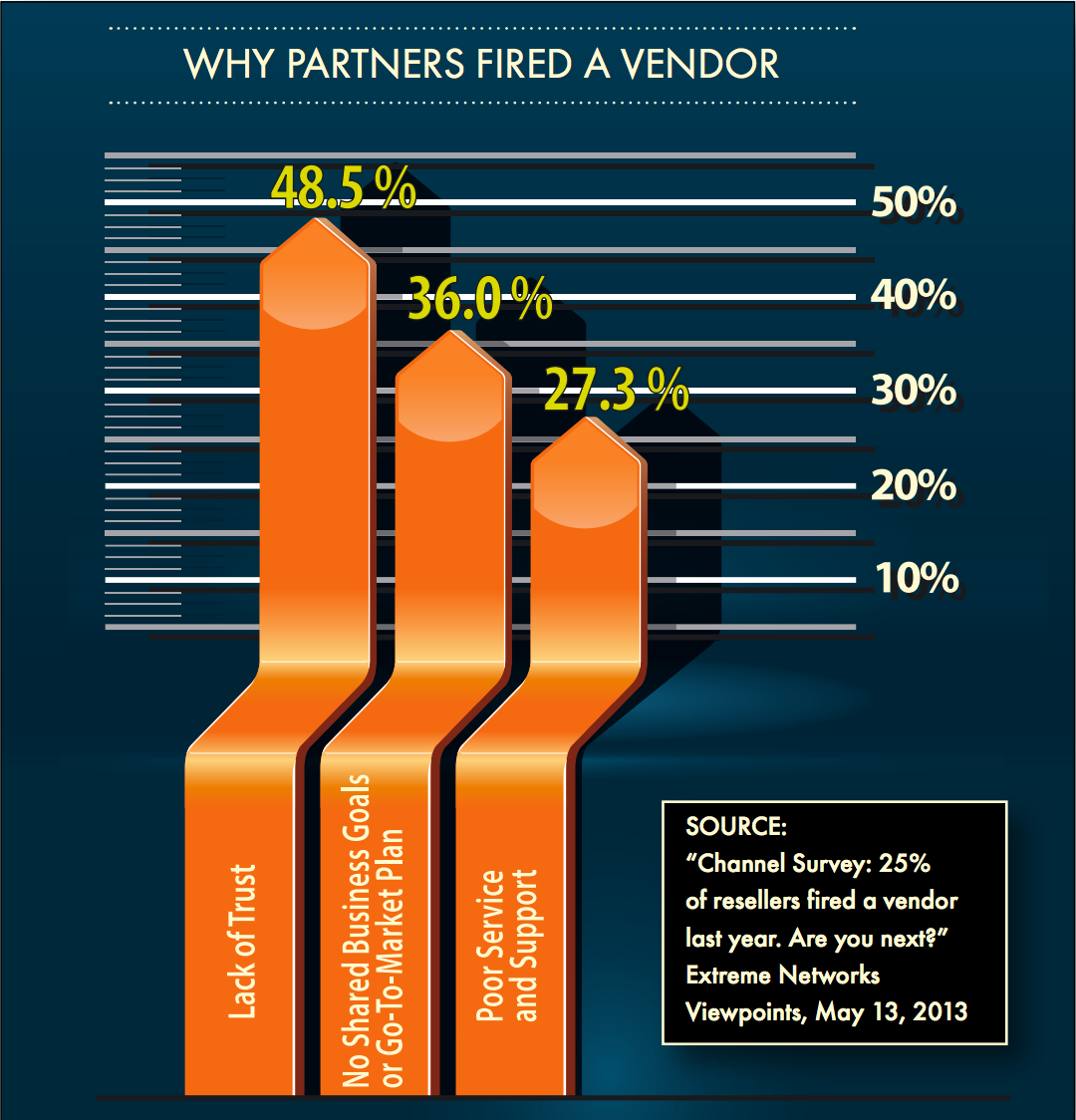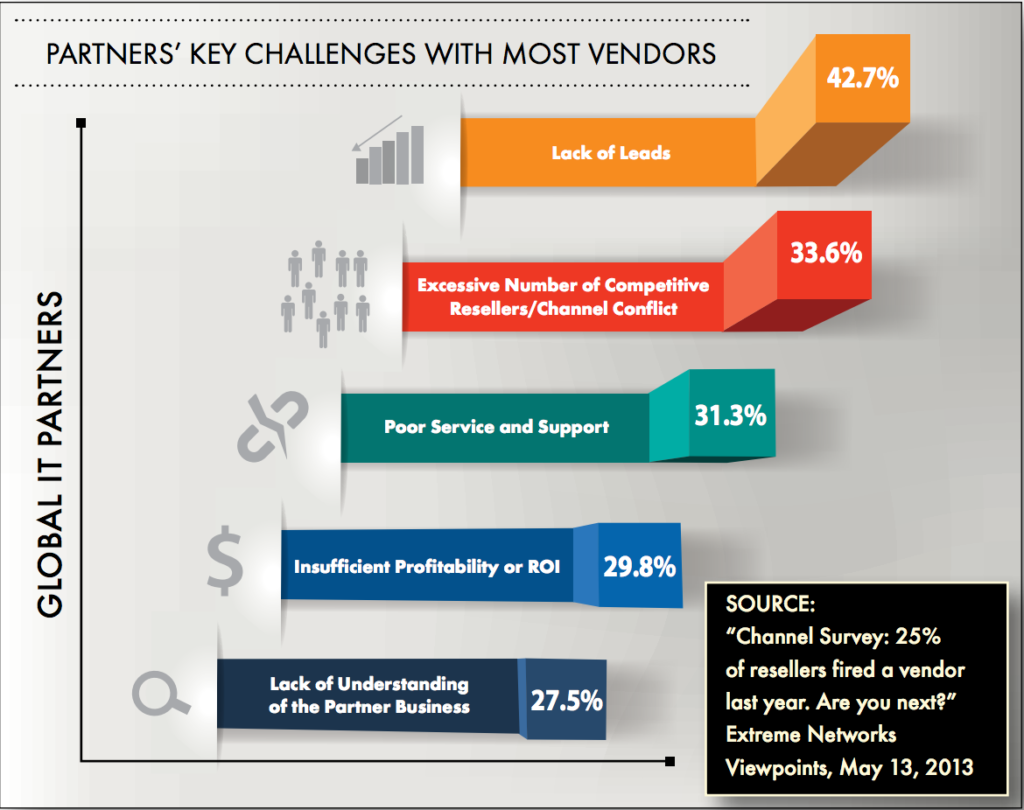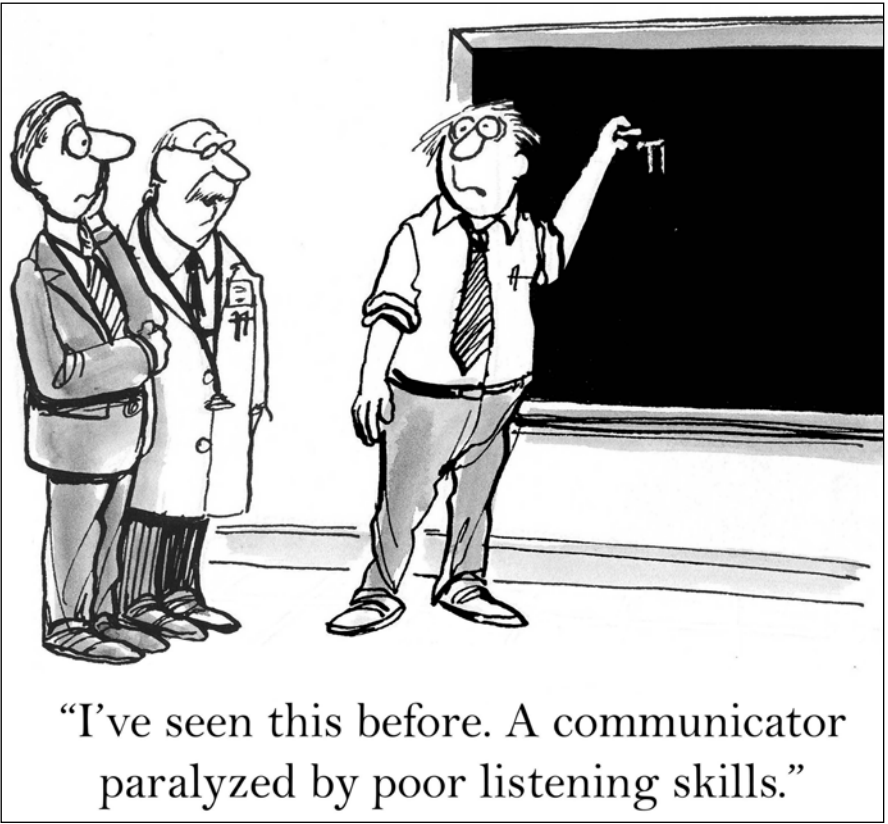This article originally appeared in ASAP’s Strategic Alliance Magazine (Q3, 2015)
Many Channel Sales Partners are Unhappy with Their Vendors. Today, if a Channel Partner is not Treated as a Legitimate Business Partner, the Partnership will not Work.
One in four resellers worldwide, and a third in the United States, have fired a vendor, according to a 2013 channel survey conducted by Extreme Networks (formerly Enterasys). The number one reason for the firing, at 48.5%, was lack of trust. “Half of all value-added resellers (VARs) selling products as a cloud service aren’t satisfied with how their vendors listen to and act upon their feedback,” according to a 2014 ZS Associates study. And the results from Business Solutions Magazine’s Best Channel Vendors 2015 survey of solution providers shows that only 15 companies out of the top 51 vote getters won the “Channel Friendly” category, three companies won the “Channel Program” category, and two companies were tops in both. The majority of the large companies under General Computing, Networking, and Network Security did not receive top votes for “Channel Friendly” or Channel Program, and merely four companies received top votes in the Adequate Margin category.


The sales “channel” that we know today has been around since the mid 1980s. After 30 years, it would be expected that vendors would know how to treat and interact with their partners. The surveys cited above say something different. Simply stated, if a channel partner is not treated as a legitimate business partner, the partnership will not work.
Before there is a channel program, there must be a relationship.
Why would a solution provider want to sell a vendor’s products and services if there is not a mutually beneficial business partnership? The results of the aforementioned surveys indicate they probably won’t. And if a vendor expends time, effort, and resources to create a channel program and recruit partners, shouldn’t the outcome be a profitable and sustainable business relationship? Before sales incentives, marketing development funds, spiffs, and most certainly metrics, there is the vendor-partner relationship. If there is no relationship, there is no partnership. Consequently, there is no reason to have a channel organization if you are not committed to developing a strong partnership that is set up for success. But, if you are committed to creating a well-performing channel, how can it be optimized through relationships? How does a vendor create an environment that fosters fruitful channel partnerships? I asked a number of channel executives, consultants, and partners for their thoughts on channel relationships, why they are so important, and which areas of the partnership they affect. Here is what they had to say.
The Channel as Your Customer
If you want a profitable channel organization, a good start is to create a mindset that your channel is your customer. “I look at partners as a customer, and I think vendors need to treat them that way,” says Steve Perry, president of Pereion Solutions (http://www.pereion.com/).
But, how is that done? How should these customers be treated? “With a sense of partnership. With the sense that you’re on the same side,” responds Steve Dorfman, customer experience consultant for Driven to Excel (http://blog.driventoexcel.com/). “Too often in business, customers get the sense that you’re on one side of the table and they’re on the other side of the table.
“And I believe that we should look at customers as future friends,” Dorfman continues. “You know, imagine that. Imagine you’re a customer and you’re striking up a relationship with a vendor and that person is looking to you as a future friend. It just changes the game. It changes the mindset. It changes the tone. And it’s not to say that things would then become less professional. It’s just to say that you have this sense of partnership with this person; that you’re looking out for their best interests and, in some cases, maybe putting their best interests or their interests before your own.”
But is it a good idea to get that personal?
Rich Blakeman, of Channel Enablers, in his article “It’s not personal; it’s business,” makes the case that “Partners are an extension of your brand. To many end customers, partners are your brand. As you create and reinforce relationships with those partners who create both revenue and customer experiences, how much time do you spend getting to truly know and create personal relationships with them? Not golf course relationships or cocktail relationships: the kind of relationships that would cause you to say, ‘It isn’t business, it’s personal.’”
Channel Partner Recruitment
Before or during the partner recruitment process is the time to develop your channel relationships
For a traditional distribution channel, “the recruitment process can be a little more broad and therefore can cast a wider net before a relationship can be established,” explains Travis Smith, founder and chief writer for Move the Channel and MoveTheChannel.com. He goes on to say, “But when you’re selling into strategic markets, you are looking for partners to bring value, and enhance, your solution by bringing in a solution sales approach to a more complicated sale. In these instances there needs to be a relationship before the recruiting process. And the partnership needs to develop organically through mutual customers or through consistent crossing of paths at industry events. So ideally the relationship starts before the recruitment process, and then once that’s been identified then you can start to recruit and make a much more sound business case for the partnership.”
Bob Skelley, vice president of global channel for Infinio (http://www.infinio.com/), concurs that having a history with channel partners can be essential to creating or continuing a relationship during recruitment.
“If you have those relationships—and in many cases those span much longer than one company and one technology—leveraging the trust you’ve built in the past can be a great driving force,” he says. On the other hand, “when the relationship is fairly new and recruitment and building that relationship is a priority, then I think helping the partners see the value and the opportunity of working together has to be the right first step.”
Helping Partners Build Their Businesses
Once a relationship is established, the essential endeavor is to help your partners build their business.
Perry says this is the most important part of the relationship, “understanding the partner’s business and then helping them to grow their business. Because I think if you can do that, if you have that understanding and you’re working with them at that level, you’re able to create a win-win relationship for both parties.”
“It’s critical,” answers Smith. ”The difference between a good partnership and average partnership is the investment in the relationship. To be a top notch A-tiered partner you need to take the time to understand your partner’s business.” Elaborates Bob Skelley of Infinio, “You need to understand how that solution provider has structured their current vendor portfolio, you have to make sure that your company and technology is going to be a fit with that strategy, and if you’re going to build a long-term lasting relationship there has to be a fit for both companies. So it’s really important that you understand the partner’s strategy, how are they going to market, the decisions they’ve made to build that vendor strategy, and then where does your company, your go-to-market model, and your technology fit within that strategy. It has to be a bi-directional dialog or else you’re really not building a partnership.”
Understanding a partner’s business model and how they make money means that you have spent the time to get to know them, and have shown that you care about the partnership.
Communications and Trust
For solution providers, the critical elements of their vendor-partner relationship are communications and trust.
“If we’re working hard, for evangelizing for the vendor and the product, we would like to be treated as such,” according to Susie Watkins, solutions vice president for Network America (http://ldms.com/). “We want to be respected for the value that we bring. And I think what we’re looking for in return from the vendor, outside of that, is to be communicated to, to be in the fold— to know about product, roadmaps, and new strategies coming down.” She advises, “Number one for a vendor, when they’re picking up a channel program, is to remember that, if we’re going to be out there selling for them they need to tell us what’s going on.”

“I think trust is one of the key things,” says Richard Laskey, vice president of sales and marketing for BizCarta (http://www.bizcarta.com/). “Trusting that your channel partner is taking the steps to get themselves to the point where they are proficient at being able to move the technology is important. And then communications, having a point of contact that understands the value of the partnership, and having that open dialog so that when a customer is being worked on, that information is being passed back and forth and the prospect and the opportunity is being moved forward by both parties, and that I think is critical. It has to be a true partnership, otherwise it’s just talk. It’s not the real deal.
The Channel Account Manager
Because they manage all the aspects of the vendor-partner relationship to ensure it is on track, the most vital member of partnerships are your channel account managers (CAMs). Their priority is to help partners successfully grow their business. For many partners, the CAM is usually the only line of communications they have with the vendor.
“Channel account managers are extremely important, as they are the key interface for partners into the organization,” believes Marie Russell, director, federal marketing for Juniper Networks (http://www.juniper.net/). CAMs are “actively working to bring key resources from the vendor to build the relationship, including product management, training, marketing, etc. Ultimately, they are responsible for the success of the partner relationship.”
“I think it’s a critical role,” asserts Perry. “You need to understand your partner’s business. And good channel account managers truly understand their partners’ businesses, and they’re able to focus on what’s important to the partner and put their own reward system secondary, but be able to drive to that by doing what’s right for the partners and helping their partners to actually grow in a way that makes sense for their business. So a good channel account manager, like a good sales representative, understands their channel partner and is really helping them grow.”
What do the solution providers think?
“It’s important having somebody that understands, has that background and understands the benefits of how a good partnership can work and how much reach it can extend,” says Laskey. And for Watkins, it is “key, because that’s the person that the channel is going to be interfacing with the most. And they have to understand channel; they just really need to have that background.”
Investing in Relationships Pays Off
Strong vendor-partner relationships are the basis for a positive and profitable channel partnership. They take a lot of work to be successful. As Watkins bluntly says, “Don’t go in half-assed.”
“Over time, relationships can become very close as a natural extension of the sales team, Russell says. “The vendor can elevate the relationships with partners with special celebrations, ‘can’t miss’ partner conferences at memorable locations, and meaningful awards. I remember a top distributor that always had cookouts for our team when we came to town as a celebration. One year my family and I arrived at our Disneyland hotel, where one of my top partners had a bottle of champagne and fruit waiting, wishing us a great vacation.” That gift says it all.
Marie concludes, “Partner relationships must be cultivated by both parties over the long term, and when done right, are well worth the investment.”
